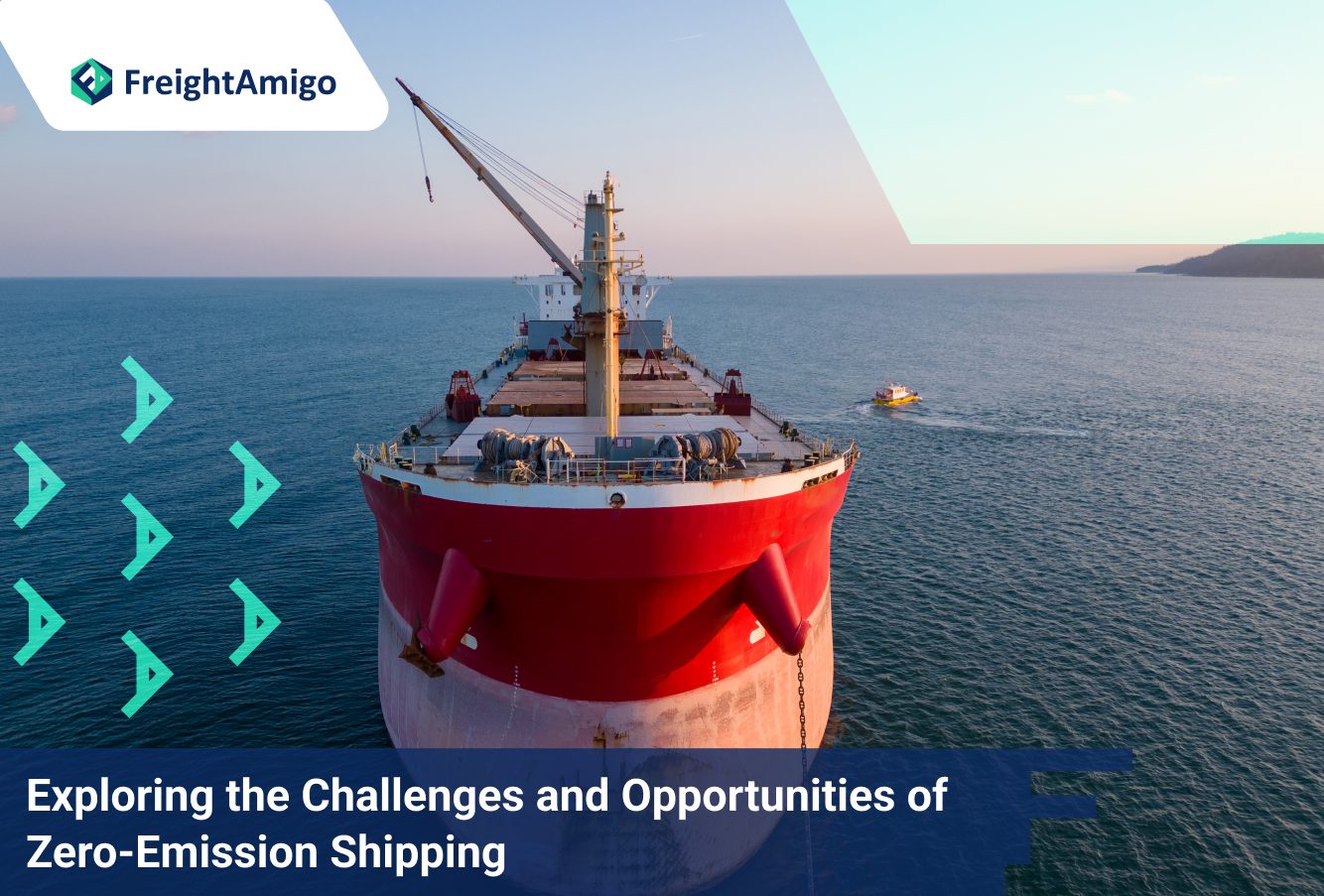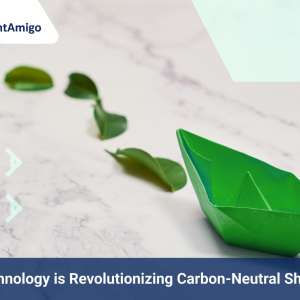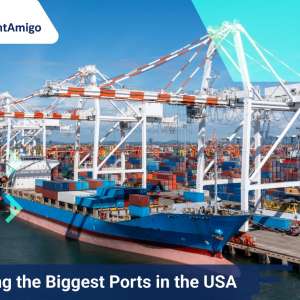Exploring the Challenges and Opportunities of Zero-Emission Shipping
Latest update on 3 April, 2024 by Aiden Ng– Marketing Analyst at FreightAmigo
In today’s world, where the effects of climate change are becoming increasingly apparent, the need for sustainable practices is more pressing than ever. One industry that plays a significant role in global emissions is shipping. Transporting goods by sea contributes to air pollution and carbon emissions, making it imperative to explore alternative solutions. This is where zero-emission shipping comes in.
Zero-emission shipping refers to the use of technologies and practices that eliminate or significantly reduce greenhouse gas emissions from ships. By transitioning to zero-emission shipping, we can reduce the environmental impact of the shipping industry and move towards a more sustainable future. However, this transition is not without its challenges. Through this article, FreightAmigo can help you keep up with the latest logistics trends and understand more about zero emission shipping.
Want to compare the best Express, Air Freight, Sea Freight, Rail Freight & Trucking rates so as to have better control on cost?
Challenges in implementing zero-emission shipping
Implementing zero-emission shipping poses several challenges, both technological and economic. One of the main challenges is the development and deployment of appropriate technologies. While significant progress has been made in this area, the scalability and cost-effectiveness of zero-emission technologies remain key concerns. The shipping industry needs solutions that are not only environmentally friendly, but also economically viable for businesses.
Another hurdle is the infrastructure required to support zero-emission shipping. Establishing a comprehensive network of charging or refuelling stations for ships using alternative fuels, such as hydrogen or electricity, requires significant investment and coordination between different stakeholders. Overcoming these challenges will require cooperation between governments, industry players and research institutions.
Progress in zero-emission shipping technologies
Despite the challenges, there have been notable advances in zero-emission shipping technologies. One notable development is the use of electric propulsion systems. Electric ships offer a clean and efficient alternative to traditional internal combustion engines. These ships use batteries or fuel cells to generate electricity, resulting in zero emissions. Electric propulsion systems have already been successfully implemented in smaller vessels such as ferries and yachts, and efforts are underway to scale up this technology for larger cargo ships.
Another promising technology is the use of hydrogen fuel cells. Hydrogen-powered ships produce only water as a by-product, making them a truly zero-emissions solution. These fuel cells generate electricity by combining hydrogen and oxygen, providing a sustainable and efficient energy source for ships. While hydrogen fuel cell technology is still in its early stages, ongoing research and development is expected to lead to its widespread adoption in the marine industry.
In addition, wind-assisted propulsion systems, such as sails and rotors, are being reintroduced to improve fuel efficiency and reduce emissions. These systems harness the power of the wind to assist ship propulsion, reducing reliance on fossil fuels. Combined with advanced weather routing and optimisation algorithms, wind-assisted propulsion can make a significant contribution to reducing greenhouse gas emissions from shipping.
Business opportunities in zero-emission shipping
While the transition to zero-emission shipping presents challenges, it also opens up new opportunities for businesses. As demand for sustainable shipping solutions grows, there is a market for companies that can provide innovative technologies and services. Companies involved in the development and manufacture of zero-emission ship components, such as batteries, fuel cells and alternative fuels, will benefit from this emerging market.
In addition, companies that offer sustainable logistics and supply chain solutions can gain a competitive advantage. As consumers become more environmentally conscious, they are likely to favour companies that prioritise sustainability in their shipping practices. By embracing zero-emission shipping, companies can attract environmentally conscious customers and enhance their brand reputation.
In addition, the transition to zero-emission shipping can lead to job creation and economic growth. The development and deployment of new technologies and infrastructure will require skilled workers, creating employment opportunities in a variety of sectors. Governments and organisations can invest in training programmes and initiatives to equip individuals with the necessary skills for the zero-emission shipping industry.
Government initiatives and regulations promoting zero emission shipping
Governments around the world are recognising the importance of zero-emission shipping and are taking steps to promote its adoption. Many countries have introduced regulations and incentives to encourage the transition. For example, Norway has launched a Zero Emission Fjord Initiative, which aims to have only zero-emission ships operating in its fjords by 2026. The European Union has set ambitious targets for reducing greenhouse gas emissions from shipping and is funding research and development in this area.
International organisations, such as the International Maritime Organisation (IMO), also play a crucial role in promoting zero-emission shipping. The IMO has set targets for reducing emissions from shipping and is working to develop regulations that support the adoption of sustainable practices. These initiatives are creating a supportive environment for companies to invest in zero-emission technologies and are driving the transition to a greener shipping industry.
Future prospects and trends in zero-emission shipping
The future of zero-emission shipping looks promising. Advances in technology, coupled with increasing awareness of the need for sustainability, are driving the industry towards a greener future. The adoption of zero emission shipping is expected to accelerate in the coming years as more countries and companies commit to reducing their carbon footprint.
One notable trend is the integration of digitalisation and automation in the shipping industry. Digital solutions, such as smart shipping systems and data analytics, can optimise vessel performance and reduce energy consumption. Automation technologies, including autonomous ships and unmanned aerial vehicles for cargo inspection, can further improve efficiency and reduce emissions.
Collaboration between industry players, research institutions and governments is also likely to increase, fostering innovation and knowledge sharing. Sharing best practices and lessons learned can accelerate the development and deployment of zero-emission technologies. These collaborations can also lead to the establishment of international standards and regulations, ensuring a consistent approach to sustainability in the shipping industry.
Conclusion: The importance of the transition to zero-emission shipping
In conclusion, the challenges and opportunities of zero emission shipping highlight the urgent need for the shipping industry to transition to sustainable practices. The environmental impact of traditional shipping methods cannot be ignored and it is imperative that we explore and adopt alternative solutions. While there are obstacles to overcome, advances in technology and supportive government initiatives provide a solid foundation for the adoption of zero emission shipping.
By moving to zero emission shipping, companies can not only contribute to a greener future, but also gain a competitive advantage. The market for sustainable shipping solutions is growing, and companies that prioritise environmental responsibility can tap into this growing demand. In addition, the transition to zero-emission shipping can lead to job creation and economic growth.
The journey to zero emissions shipping may not be easy, but it is necessary for the long-term sustainability of our planet. With the help of FreightAmigo, you can easily find a more sustainable and environmentally friendly solution!
The best way to find a more sustainable solution is with the full support of logistics experts! To find out more about zero-emission shipping, please visit the FreightAmigo enquiry page.
If you have any inquiries on logistics/supply chain, feel free to contact FreightAmigo now:
Chat with us online | Hotline: +852 28121686 | WhatsApp: +852 27467829









































